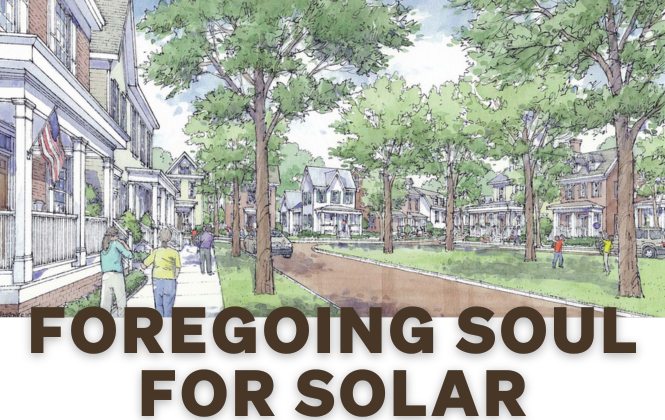
Solar Developer preempts Chestertown Greenbelt Master Plan to site array at Clarke-Hopewell Farm
My love for the Eastern Shore started in Chestertown. I used to visit each fall for the Chestertown Wildlife Art Festival and it was one of my favorite weekends of the year. Big groups of migrating Canada geese would hang in the air, as would that first real bite of autumn chill. The magic of Chestertown, like so much of the Eastern Shore, is in its close interplay of vista and village. Just a stone’s throw from my favorite bookstore one can enjoy the rural countryside in full, by paddling Radcliffe Creek, cycling a scenic byway, or photographing combines bringing in the harvest.
At the same time, I was making those trips to Chestertown, around 2007, Eastern Shore Land Conservancy was working with the Town of Chestertown, Kent County, and a professional planning firm, to create the Chestertown Greenbelt Master Plan. The master plan was meant to encompass the future of the Clarke-Hopewell farm, described by Chestertown Mayor David Foster as “our only real opportunity for expansion of Chestertown.” The nearly 500 acre farm, located northeast of Chestertown’s historic downtown, is one of the last remaining sizeable undeveloped tracts within the Chestertown Planning Boundary.
This was before the Great Recession and there were plenty of questions about how development would shape the future of Chestertown and the entire Eastern Shore. So enter the master plan, developed with strong input from the community, to ensure that future development of the Clarke-Hopewell farm would serve as an “organic extension of the historic fabric of the town,” an effort to replicate in Chestertown’s future what had worked so well in its past.
One of the questions that was asked during the inevitable community workshop nearly twenty years ago was: “What defines the character of Chestertown, and should be reflected in this new part of town?” Responses include: “historic…small town feeling…neighborhood feel…walkable…life on a human scale.” Those words do a nice job describing what works about Chestertown. The master plan hews closely to these ideas, providing a flexible and iterative development program designed to “accommodate much of the growth of the town and the county over the next 50-100 years.” The plan includes hamlets and villages, each of which incorporates mixed-use buildings, civic uses, and neighborhood greens.
In 2015, the Chestertown Greenbelt Master Plan was incorporated formally into the Chestertown comprehensive plan. It was memorialized in a beautiful leather-bound volume that sits on a shelf here at the Eastern Shore Conservation Center. Increasingly, it looks like that is where the master plan will stay.
Instead of human-scale hamlets, what now seems poised to occupy the Clarke-Hopewell farm is a 45-megawatt utility-scale solar array. The array will send power straight to the grid, keeping lights on and computers buzzing in homes and businesses and data centers as far away as Illinois. And all of this has been planned despite the clear and formal opposition of Chestertown and Kent County.
This change came about because the solar developer, a subsidiary of a massive Canadian-based asset management company, petitioned for, and was granted a Certificate of Public Convenience and Need (or a CPCN) from the State of Maryland. What does this mean? Well, in this case, the CPCN serves as a kind of permission slip, signed by state government, allowing the solar company to work around time-tested and well-understood local land use decision making processes. This is referred to as preemption, since local zoning rules, planning commissions, and comprehensive plans are ‘preempted’ by the CPCN, which serves as a kind of blanket approval for land use and site plans that might otherwise be inconsistent with local wishes.
State preemption of local land use rules is being done in the spirit of addressing the challenge of climate change head on, for which the state has adopted aggressive renewable energy generation goals. But in the rush to site solar power, the pendulum has swung too far. The playing field is too unlevel. Parcels close to our towns and designated growth areas deserve careful attention, responsible land use, and close examination. In Chestertown’s case, the state’s CPCN is plowing through the town’s best laid plans and taking off the table a parcel that was meant to accommodate well-planned growth for the next fifty years or more. Instead of public parks, community orchards, and apartments that young people can afford and easily bike from, instead of tree-café-playground-garden-cottage-barbershop we’ll have panel-panel-panel—more than 140,000 modules.
Solar panels do not need fertile soil. They do not need to have their hair cut and they do not need to bike to class in the morning. There are many other places solar can go. Where else is Chestertown supposed to go? There are not many other spaces the rest of Chestertown can grow into. At least not without contributing to the Eastern Shore’s “auto-oriented suburban sprawl which threatens to erode its rural character.”
In the race to site solar power as quickly as possible, the Eastern Shore looks increasingly attractive. But we must have some balance, some way to say “Here, but not there.” Many of our open acres are best at producing food, and they should remain in agriculture. Other acres, located nearest our towns, are best suited for new neighborhoods. Some spots are well-suited for solar generation. But when we write a new set of rules that only applies to solar, the balance is thrown off in favor of a single land use.
Rather than allowing Chestertown to “grow harmoniously… slowly and methodically as to maximize the efficiency of its land use,” as the Greenbelt Plan so eloquently states, we will allow our land to be “rapidly digested.” The Eastern Shore will lose.


